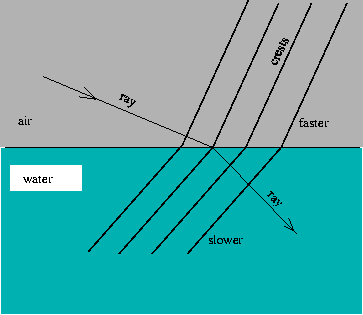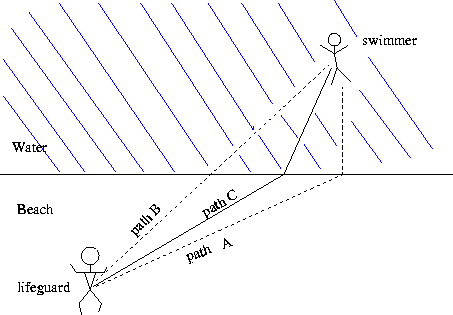




Next: Dispersion
Up: Wave phenomena
Previous: Wave phenomena
Refraction
Refraction is very easily understood within the wave model of light if one
recalls that light slows down as it enters a more dense medium. If you imagine
a long wave front approaching water from the air, as shown below.
Figure 10.13:
Refraction of Waves
 |
The part of
the wave front that is already in the water is going more slowly than the
part that is still in the air. As a necessity, the wave front in the water
``turns'' inwards as shown. Think of a truck driving from pavement onto sand
at a steep angle. The two front tires represent either end of a plane wave
front (the truck's front axle). If the right tire hits the sand first it will
slow down relative to the left tire, so that the axle (and hence entire
truck) turns to the right. This is precisely how refraction of light
works.
It is interesting to note that refraction of light is not definitive
proof that light is a wave, since there is a way to explain it in
terms of particle behaviour, as long as we are willing to make one
additional postulate. Suppose that light is indeed made up of
particles,and these particles slow down as they enter a more dense
medium. Let us postulate that the particles of light follow paths that
minimize the time it takes to arrive wherever they are going. This is
called the principle of least action. We can understand
the basic idea using the following heuristic description,
due originally to Richard Feynman. Imagine that you are a life guard
on a beach, and see someone drowning several meters off shore, as
shown in the Figure below.
Figure 10.14:
Principle of Least Action
 |
Naturally you wish to get to the swimmer in
the least amount of time possible. You know that you can run on the sand
faster than you can swim, so you would like to spend as little time in
the water as possible. One possibility is to run along the shore until
you are directly opposite the drowning swimmer, and then swim from
there, as in path A. The trouble is that this path is very long. An
alternative approach would be to take the short path, (path A) which
is the straight line between you and the swimmer. However, with this
path you spend a fair bit of time swimming. It turns out that the
correct path for optimizing the time it takes is the one that is a compromise between paths A and B, namely
path C in the figure. Given the relative speeds on the sand and in the
water, there is a specific angle through which you have to ``refract''
in order to have the greatest chance of saving the swimmer. If one
applies this argument to light, one gets precisely the right quantitative
predictions for the refraction of light. One must keep in mind that
this behaviour is very natural for lifeguards, who know where they
wish to go and why, but is, to say the least, a bit strange when
applied to particles of light. So at this stage, it seems easier to
just think of light as waves.





Next: Dispersion
Up: Wave phenomena
Previous: Wave phenomena
modtech@theory.uwinnipeg.ca
1999-09-29
